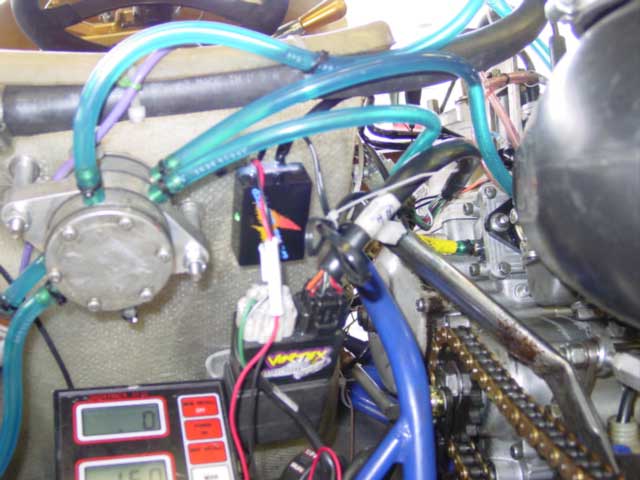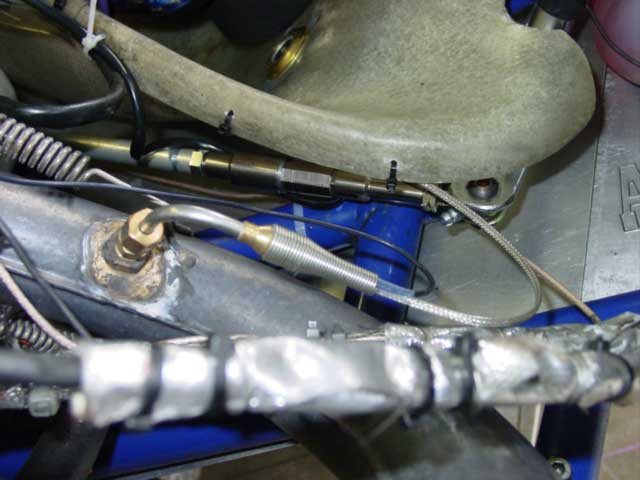 Kart Electric
Shifting Systems Kart Electric
Shifting Systems
| BS4-KART1-2 |
BATTLE KART SHIFTER (COMPRESSION) CR/RS125 and other single
cylinders |
|
| BS4-KART1-3 |
BATTLE KART SHIFTER (EXTENSION) CR/RS125 and other single cylinders |
|
| BS4-KART2-2 |
BATTLE KART SHIFTER (COMPRESSION) 250cc Twin cylinders
|
|
| BS4-KART2-3 |
BATTLE KART SHIFTER (EXTENSION) 250cc Twin cylinders
|
|
| | |
|
We encountered the latest and the hottest add on product for shifter karts
at a recent road-racing event at New Hampshire International Speedway. This
is a device you can either use or be assured that you will be beat by it
every time at every track.

The product is called the Battle Shifter. As with most elegant solutions it
is a dream in simplicity. The Battle shifter is a semiautomatic shift up
system. The Battle Shifter provides smooth shifts every time with your foot
firmly planted on the throttle, there is no need to lift your foot.
The battle shifter works by automatically adjusting the current flow to the
ignition coil of your moto or ICC coil. The Battle Shifter is not an
interrupter that cuts power to the ignition system it merely balances the
current flow to achieve smooth shifting. This is an exceptionally smart
device the Battle Shifter adjusts shift timing to match engine RPMs this
compensates for the fact that as the engine speed increases the shift window
decreases. The effect is that you sustain your engine RPMs and your kart
momentum and decrease your lap times.

The Battle Shifter answers the desires of every shifter driver. Hold the
throttle down and shift with all of the confidence in the world that the
engine and transmission will be in perfect harmony. To achieve the correct
adjustment or current reduction to the coil the Battle Shifter has a tunable
delay. There are 10 positions on the tunable delay. If the delay that you
have selected is to long there will be a detectable speed drop while
changing gears, if it is to short there is some noticeable shock when
changing gears or if exceptionally short there may even be an issue of
getting the shifter into high gear. The adjustment is easier than setting
the dial on your car radio.
Because the Battle Shifter is not a current interrupter there is no impact
upon your instrumentation. There have been other products for motorcycle
applications but they disrupt the ignition circuit and cause havoc with on
board instrumentation causing the instrumentation to flash and potentially
harming ignition components with current surges. This does not occur with
the Battle Shifter.
Once installed the system is a dream to use. The first issue is teaching the
driver that there is no need to lift on the upshift. On the NHIS road
circuit there are eighteen (18) shifts per lap so the driver had plenty of
practice on each lap.
For our first laps we had the delay set at five (5) and we could hear a
slight burp with each shift, we moved the adjuster to eight (8) which
shortened the current reduction and it was near impossible to tell that the
driver was shifting. Standing at pit wall at what we knew was a shift point
we were asking ourselves, did he shift?
The performance impact is dramatic. With manual shifting we were seeing
dramatic RPM drops and recovery at each shift. Some of the lower gear
changes we were loosing several thousand RPMs per shift and were still over
1200 RPMs as we got to higher gears. With the Battle Shifter we were
experiencing as much as 60% reduction in RPM loss. This means that the RPM
drop is measured in hundreds and not thousands of RPMs. Do not forget this
was only our first time using the battle shifter and had only two short
practice rounds so we anticipate that as we really learn how to tune the
device that we will gain even greater performance.
Just think about what that means with eighteen shifts per lap and not having
to recover the RPMs that you are loosing per shift that translates into
tenths of a second or more per lap and all you did was bolt on a Battle
Shifter. This is not even an option this is a must have. The Battle shifter
also has a built in safety which disables the devices ability to reduce
current to the coil should engine RPMs fall below 3000 RPMs this is to
prevent the kart from stalling at a low speed.
It appears that shifter motor types are irrelevant. If you can remove the
input wire to the coil and replace it with the push on spade lug from the
Battle Shifter and then connect your normal coil wire lead to the battle
shifter wire harness, your wiring is half done. The next step is to connect
the 12-volt power source. We used eight (8) AA batteries in a Radio Shack
battery holder and the push on connectors that are common for connecting all
9-volt batteries. It could be wired directly to your CDI.
The unit that we acquired is a compression model meaning that the driver
pulls back on the shift lever to up-shift. If you have a kart and motor
combination requiring the driver to push the shift lever to up-shift then
you will want a different model that is the extension model as opposed to
the compression model. Be sure that you know the direction of travel of the
shift lever to up-shift before you plan your installation.
The installation is exceptionally simple. It does however require altering
the shift lever to accommodate the battle shifter. We opted to have our
engine builder fabricate a new shift rod for us as his shop is close to the
racetrack.
When you install and adjust the shift rod it is exceptionally important that
you leave a least one (1) mm of space between the switch body and locking
nut on the shift rod, otherwise the rod won't move. If the rod does not
move, it does not compress the switch that is locates within the shiftrod
and the shifter will not function.
As we read the directions the manual indicated that the unit needed a power
source. The specs indicated a range of 9V-14V DC and a current requirement
of 12mA to 37mA so we opted for a quick stop a Radio Shack where we
purchased a AA battery holder that held eight (8) AA batteries and this gave
us 12 volts. We thought about trying to tap our Vortex CDI for the 12 volts
but we all lacked the knowledge to tap the CDI just prior to a race.
We have learned that all that is necessary is to contact the supplier of
your CDI and they can identify the 12-volt hot wire and you can attach the
Battle Shifter directly to your CDI. The current draw is so minimal that we
have been assured that there is no negative impact on the CDI. I have sent an
email to the importer of the Vortex CDI that we run on our kart and for our
next race the Battle shifter will be powered from the CDI. The beauty of
this solution is that the Battle Shifter is always on when the motor runs
and shuts itself off when the motor stops.
The wiring diagram is simple the red lead goes to the plus side of the 12
volt power source the black lead to the negative side of the 12 volt power
source. White lead goes to the ignition coil, remove your hot lead to the
coil and replace it with the white lead. The lead that you removed connects
to the blue lead. It is just a plug in as it was in its original connection
to the coil. There is one other lead with a 2P connector that connects to
the mechanism that is now part of the shift lever. The wiring is done. There
is no complexity that is beyond the average grade school student. Dads who
decline to read directions should feel free to engage their son or daughter
for advice.
A strong suggestion is do the preparation at your home or shop. We used some
crimp type wire connectors as it was the expedient thing to do at the track.
We suggest that you solder the wire connectors and use heat shrink tubing to
cover the connections. This will really improve the reliability of the wire
connections and assure fault free performance.
The next installation step is to reconnect both ends of the shift lever.
Before you get the shift lever in position make sure that all hardware is
adjusted correctly and that all of the jam nuts are tight. Again remember 1
mm of space to allow the shift rod to compress within the battle Shifter.
There will be both left and right-hand jam nuts so be sure that you are
tightening as appropriate. As with all shift rod applications there is the
need for a left hand tap for on of the hyme joints so we left this work to
the motor builder who had all of the needed tools. A note of caution. The
Battle shifter mounts in the shift rod where the rod is straight. The
Manufacturer does not suggest mounting the Battle Shifter where the rod has
a bend. There is sufficient length in all shifter karts to accommodate for
correct mounting.
Make sure that both ends of the shift lever are tight and that the lever
moves freely and does not rub the seat or the chassis.
Now route all of the wires in a neat manner and locate the controller box.
We selected a location near our Vortex CDI as we were sure that we had no
high voltage leads such as tach sensors mounted near the box as the
instructions suggest the box be located near the CDI and away from excessive
heat or vibration. We used industrial strength Velcro and attached the
controller to the back of the seat. Be sure that you have access to the side
of the Battle Shifter controller box for the small Phillips screwdriver that
comes with the kit so that you can adjust the delay to match your drivers
ability.
With the new shift rod in hand the installation was under 10 minutes.
To test the Battle Shifter after you have completed the installation just
grasp the shift handle and move the lever as though you were executing an
up-shift. A small red LED will illuminate on the Battle Shifter controller
box to indicate that the unit is functioning properly.
We got the battle shifter from Steve Aspland (former owner) of Rising Sun Cycles as he is
the exclusive importer. Stewart (new owner) imports Grand Prix Motorcycles from Japan and
specializes in all types of high performance motorcycle products. Rising Sun
Cycles,
www.rscycles.com or email
[email protected]
The Battle Shifter in a kart ready configuration is available from Bill
Price Racing, 86 Shannon Road, Gilmanton Iron Works, New Hampshire 03837
(603) 364-BILL, email: [email protected]. Bill�s team has developed
shift rod packages for a host to motor and kart combinations so call or
email for price and delivery.
If you do not order one of these immediately you will not be meeting the guys
who did, as they will all be in the technical inspection line for post race
winners inspections and you will be going home without the trophy.
Bob Chiras
Crew Chief
AllKart International
603-432-4766 evenings
781-442-3045 days
[email protected]
|